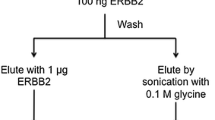Abstract—
Brain tumors are among the most intractable types of malignant neoplasms. Despite advances in the treatment of cancer, in particular, the development of new approaches in surgery, radiotherapy and chemotherapy, the incidence remains high with a low 5-year survival rate. Targeted therapy (TT) may be a solution to the problem of low efficacy of the applied cancer treatment methods. TT is based on the use of drugs that specifically affect specific types of tumors, which allows one to increase the effectiveness of treatment and minimize toxic effects on healthy tissues of the body. The combination of the unique properties of cancer cells allows one to find specific ligands that interact directly with the tumor, and to conduct TT for malignant tumors. Phage display technology is one of the promising approaches to the search for tissue- and/or organ-specific molecules [1]. Combinatorial phage peptide libraries make it possible to obtain highly specific peptides, including for various types of tumors. Currently, such tumor-targeting peptides are considered as means of targeted delivery of therapeutic genes, cytokines, imaging agents, pro-apoptotic peptides, and cytotoxic drugs. The purpose of this work was to obtain from the phage peptide library of bacteriophages exposing peptides, which ensure the accumulation of phage particles in human glioblastoma cells U-87 MG, and to assess the specificity of the selected peptides for cells of the primary cultures of human gliomas. During the research, the following tasks were solved: (1) Tumor-targeting peptides were selected using human glioblastoma cells U-87 MG in vitro and on a U-87 MG tumor in a xenograft model in vivo; amino acid sequences of selected peptides (SWTFGVQFALQH (26), HPSSGSA (92), PVSNKMS (83)) were determined; (2) primary cultures of human gliomas AS2, MG1, MG2, MG3, MG4 cells were obtained and characterized; (3) specificity of the binding of bacteriophages exposing selected tumor-targeting peptides to cells of primary cultures of human gliomas was evaluated using immunocytochemical analysis. The specific binding of selected tumor-targeting peptides with cells of the primary cultures AS2, MG1 was shown.







Similar content being viewed by others
REFERENCES
Kehoe, J.W. and Kay, B.K., Chem. Rev., 2005, vol. 105, no. 11, pp. 4056–72.
Bray, F., Ferlay, J., Soerjomataram, I., Siegel, R.L., Torre, L.A., and Jemal, A., Ca—Cancer J. Clin., 2018, vol. 68, no. 6, pp. 394–424.
Komori, T., Neurol. Med. Chir. (Tokyo), 2017, vol. 57, pp. 301–311.
Lara-Velazquez, M., Al-Kharboosh, R., Jeanneret, S., Vazquez-Ramos, C., Mahato, D., Tavanaiepour, D., Rahmathulla, G., and Quinones-Hinojosa, A., Brain Sci., 2017, vol. 7, no. 12, p. E166.
Wu, D., Gao, Y., Qi, Y., Chen, L., Ma, Y., and Li, Y., Cancer Lett., 2014, vol. 351, no. 1, pp. 13–22.
Saw, P.E. and Song, E.-W., Protein Cell, 2019, pp. 1–21.
Garg, P., J. Cancer Res. Ther. 2019, vol. 15, no. 8, p. 1.
Borgoyakova, M.B. and Karpenko, L.I., Biol. Med., 2015, vol. s2. https://doi.org/10.4172/0974-8369.S2-002.
Allen, M., Bjerke, M., Edlund, H., Nelander, S., and Westermark, B., Sci. Transl. Med., 2016, vol. 8, no. 354, p. 354.
Lau, J.L. and Dunn, M.K., Bioorg. Med. Chem., 2018, vol. 26, no. 10, pp. 2700–2707.
Marsh, W., Exploiting Phage Display for Development of Novel Cellular Targeting Strategies, New York: Humana Press, 2018.
Nemudraya, A.A., Makartsova, A.A., Fomin, A.S., Nushtaeva, A.A., Koval, O.A., Richter, V.A., and Kuligina, E.V., PLoS One, 2016, vol. 11, no. 8. e0160980.
Soendergaard, M., Newton-Northup, J.R., and Deutscher, S.L., Am. J. Nuclear Med. Mol. Imaging, 2014, vol. 4, no. 6, pp. 561–570.
Wickramasinghe, S.N., Cell Biochem. Funct., 1996, vol. 14, no. 1, pp. 75–76.
Fischer, A.H., Jacobson, K.A., Rose, J., and Zeller, R., Cold Spring Harbor Protoc., 2008, vol. 2008, no. 6, p. 4986.
ACKNOWLEDGMENTS
The authors thank R.I. Baiborodin, the Head of the Core Facilities Center “Microscopic Analysis of Biological Objects,” SB RAS, for assistance in conducting confocal microscopy.
Funding
This study was supported by the Russian Science Fund (grant no. 19-44-02006). We also acknowledge Russian State funded budget project of ICBFM SB RAS АААА-А17-117020210023-1 for supporting this work.
Author information
Authors and Affiliations
Corresponding author
Ethics declarations
All applicable international, national, and/or institutional ethical standards were followed.
Conflict of Interests
The authors declare that they have no conflict of interest.
Additional information
Translated by M. Novikova
Abbreviations: ТТ, targeted therapy; WHO, World health organization; PFU, plaque forming unit; PBS, phosphate buffer saline; BSA, bovine serum albumin; PBST, phosphate buffer saline with Tween 20; IPTG, isopropyl β-D-1-thiogalactopyranoside; PEG, polyethylene glycol; ssDNA, single-strand deoxyribonucleic acid; DMEM/RPMI, culture medium (Dulbecco’s Modified Eagle Media/Roswell Park Memorial Institute); FBS, fetal bovine serum.
Corresponding author: phone: +7 (913) 476-40-12; e-mail: maya.a.rot@gmail.com.
Rights and permissions
About this article
Cite this article
Voitova, A.A., Dmitrieva, M.D., Dymova, M.A. et al. Tumor Specific Peptides Selected for Targeted Delivery of Therapeutic Agents to Glioma Human Cells. Russ J Bioorg Chem 45, 783–792 (2019). https://doi.org/10.1134/S1068162019060384
Received:
Revised:
Accepted:
Published:
Issue Date:
DOI: https://doi.org/10.1134/S1068162019060384




